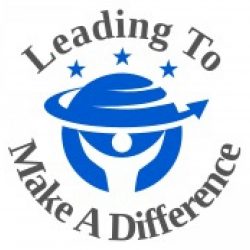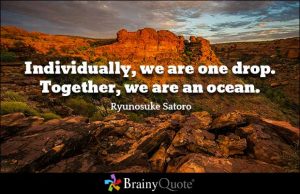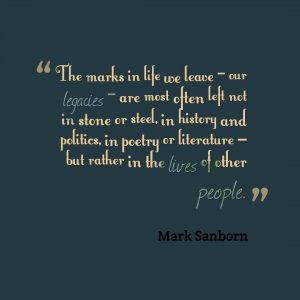Political Scientist, John Schaar, said:
“The future is not some place we are going to but one we are creating. The paths are not to be found, but made, and the activity of making them changes both the maker and the destination.”
 This message resonates with me personally and motivates me to think about what I picture my future looking like and to determine what I need to do to create that future.
This message resonates with me personally and motivates me to think about what I picture my future looking like and to determine what I need to do to create that future.
A vision is a picture of what we want to create. What is your vision for your future? Do you have a picture in your mind of what your life will look like in 5 years? 10 years? 20 years? Do you have a plan for how you can realize your vision for your future? Without a vision, and without a plan for making the vision a reality, it seems to me we are simply rolling the dice; Leaving our future up to chance. Granted, “the best laid plans of mice and men often go awry” (from “To a Mouse” by Robert Burns), but in my experience, when unexpected obstacles knock us off our course, it is easier to get back on track if we have a vision that motivates and inspires us forward.
As a leader, I believe it is also my responsibility to lead my team in creating the future for our institution and the students we serve. But first, we have to collectively agree on what that aspirational future should look like – we need a shared vision that creates a compelling picture of our future and that inspires each of us to commit to creating that future together. I also believe that the key to our team’s success lies in our ability to craft a vision that is more than just a hollow statement, and certainly more than just my vision or our leadership teams’ vision. We will only be successful if we are moving towards tomorrow together . . . And only if the tomorrow we are moving towards together is a vision of the future that incorporates the shared hopes, dreams, and aspirations of our collective team and enables personal visions to grow and thrive.
“If you are working on something exciting that you really care about, you don’t
have to be pushed.
The vision pulls you.”.
~Steve Jobs
I agree with leadership author, A. Lorri Manasse who describes vision as “the force which molds meaning for the people of an organization.” If that is true, then it is easy to see how important developing a shared vision is for any organization. I have developed a five step action list for cultivating a shared vision that unites the hopes, dreams, and aspirations of the entire team.
Step 1: Connect with your team. An article from the Harvard Business Review in January 2009 suggested that “the best way to lead people into the future is to connect with them deeply in the present.” The first step in creating an effective shared vision that will pull your team forward is to be present with your team members. You have to get to know the hopes, dreams, and aspirations of the members of the team, and share your hopes, dreams, and aspirations with them. If you don’t know what is important to them and they don’t understand what motivates you, how can you possibly create a picture of what an aspirational future for your team looks like?
Step 2: Listen. Most leaders that I know, don’t have a problem talking, but unfortunately, some have trouble understanding the importance and value of listening. This step goes hand-in-hand with step one. To truly connect with your team, you have to be present and engage with them, and the first step in doing that is to actively listen to them. Give the your time and your attention and pay attention to what they are telling you. Listening is the only way you will ever be able to really know their hopes, dreams, and aspirations.
Step 3: Ensure the vision reflects the teams’ aspirations. The team that I am privileged to lead recently doubled in size due to a restructure at my institution. Essentially, we created a new division that included the departments I was already leading and added several other departments. I added several new leaders to my team and they asked me to share my vision for our team with them. I am always happy to share my vision – I have a lot of hopes, dreams, and aspirations for our institution and a multitude of ideas for how we can support our students’ success. But what I said to them when they asked me to share my vision was that we were going to create a shared vision for our new division. My ideas will surely be a part of the vision, and I have a responsibility as the leader to ensure that our vision fits within and supports our College’s Vision and Mission, but our vision has to encompass more than just my ideas. If we are going to work toward tomorrow together, we have to create a vision that reflects our collective hopes, dreams, and aspirations for the future. It’s not about the “leader’s” vision, it is about the team’s vision.
“A vision is a clearly-articulated, results-oriented picture of a future you intend to
create. It is a dream with direction.”
~Jesse Stoner-Zemel
Step 4: Create a vision that will be the driving force for ongoing and systematic practice and process development. The vision should be the driving force for the development of practices and processes that are clearly-articulated and designed to get results that move you ever-closer towards the picture your vision has created for your future. It is important that every team member be able to see how they fit – they must understand how their role within the team, the decisions they make, and the actions they take each day contribute towards achieving the shared vision. Additionally, everyone on the team must be empowered and trusted to make decisions and to participate in the development of practices and processes. The leader’s role then becomes supportive and enabling, rather than managing and controlling.
Step 5: Secure commitment to the vision. This last step is arguably the most important. My mentor, Dr. Joseph Barwick, taught me that “power comes from one of two places: one, the authority of the position, which almost always results in abuse. Two, power is granted from the people who want to go where the leader is leading. When ‘two’ is present, the team goes way beyond job descriptions and corporate objectives.” Leaders by virtue of the authority granted them by their position are responsible for directing the work of the teams they lead. Good leaders and leaders who lead to make a difference, know that their greatest hope for success does not come from the authority of their position, but rather from their ability to secure commitment for a shared vision that motivates and inspires their teams to want to go towards tomorrow together. When this occurs, teams are no longer just workers with a job to crank out . . . They are people with a difference to make.
Be Bold . . . Be Courageous . . . Leave the world better because YOU MADE A DIFFERENCE!
Authentically yours,
Janet

 Consider too the ripple effect: Each person takes one small action that makes a difference to one person. That person in turn, makes a difference for someone else; and so forth and so on until all of the small actions combined have created a ripple — a large and forceful wave of action. Our individual contributions are like one drop of water in the ocean, but all of our “drops” combined together fill an ocean.
Consider too the ripple effect: Each person takes one small action that makes a difference to one person. That person in turn, makes a difference for someone else; and so forth and so on until all of the small actions combined have created a ripple — a large and forceful wave of action. Our individual contributions are like one drop of water in the ocean, but all of our “drops” combined together fill an ocean.